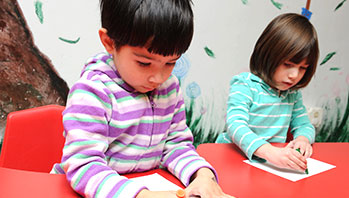- chart paper
- color poems (from Weeks 1 and 2)
- color card (orange)
- crayons and markers
- pictures (recognizable orange objects)
- color
- orange
MA Standards:
Speaking and Listening/SL.PK.MA.1: Participate in collaborative conversations with diverse partners during daily routines and play.
Writing/W.PK.MA.2: Use a combination of dictating and drawing to explain information about a topic
Head Start Outcomes:
Literacy Knowledge/Early Writing: Recognizes that writing is a way of communicating for a variety of purposes, such as giving information, sharing stories, or giving an opinion.
Literacy Knowledge/Print Concepts and Conventions: Understands conventions, such as print moves from left to right and top to bottom of a page.
PreK Learning Guidelines:
English Language Arts/Composition 20: Generate questions and gather information to answer their questions in various ways.
Draw and Write Together: What Is Orange?

© Commonwealth of Massachusetts, Department of Early Education and Care (Jennifer Waddell photographer). All rights reserved.
STEM Key Concepts: There are many colors; Two or more colors can be combined to make a new color
ELA Focus Skills: Concepts of Print, Speaking and Listening, Vocabulary
Educator Prep: Display in one area children's color poems from Weeks 1 and 2. Write the words to the poem template on chart paper or a whiteboard before the activity begins.
Revisit the color poems from Weeks 1 and 2. Read the poems aloud. Discuss what children know about poetry.
Hold up the color card and explain to children that they are going to write a poem with you about the color orange. Display the pictures or orange objects so children can see them clearly. (e.g., an orange, a pumpkin, flowers, a butterfly)
- Ask children to describe the color orange. Ask, Can you think of something that is the color orange. How would you describe that object? Encourage children to use the color vocabulary they have learned over the past few weeks.
- Read the poem template and track each line as you read it aloud slowly. When you come to the first blank, think aloud and model as you say, Orange what? What is something that is orange? My fluffy cat, is orange! I will write fluffy cat on the first line. Continue to read the verse and allow children to fill in the blanks.
- As you read, continue to track the words with your finger. Point out how you begin each sentence at the left side of the page and read to the right.
What is Orange?
Orange things are all around.
I see an orange ,
And an orange .
I see orange all around!
I see an orange .
And an orange .
I see orange things all around!
Take It Further: You may want to invite volunteers up to the poem chart to illustrate the responses.
Social Emotional Tip: Writing group poetry helps children develop their understanding of group dynamics and expectations, and provides an opportunity to understand how one’s actions and thoughts can affect others.
English Language Learners: If English Language Learners have trouble putting their ideas into words, let them draw quick sketches and/or illustrate parts of the poem, then you can help them find the English words to use.
